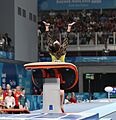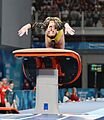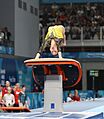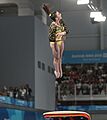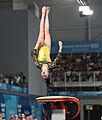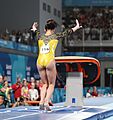Yurchenko vault family facts for kids
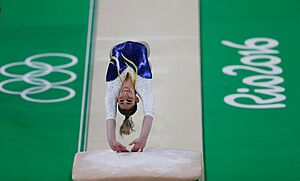
Yurchenko vaults are a super popular type of vault in artistic gymnastics. They are sometimes called round-off entry vaults. To do one, a gymnast first does a round-off onto the springboard. Then, they perform a back handspring onto the vaulting table. After that, they launch into the air for a salto. This salto can be simple, like a single tuck, or very complex, like a triple twist layout. The harder the salto, the more points a gymnast can earn! This amazing vault is named after Natalia Yurchenko, who first performed it in 1982.
Contents
The Story of the Yurchenko Vault
The Yurchenko vault gets its name from Natalia Yurchenko. She was a talented gymnast who worked with her coach, Vladislav Rastorotski. Together, they came up with a brand new way to approach the vaulting horse.
They first practiced this new move safely in a foam pit. Once they felt ready, they tried it on the actual runway and vault. In 1982, Natalia showed off her amazing new vault for the first time at a competition in Moscow. People were very impressed!
The vault became even more famous when Yelena Shushunova won a gold medal at the 1985 World Artistic Gymnastics Championships using a full-twisting Yurchenko vault.
In 2001, a new, safer vaulting table was introduced. This made Yurchenko vaults even more popular because there was less risk of injury. By the 2009 World Artistic Gymnastics Championships, almost every female gymnast was performing a Yurchenko vault. Today, it's one of the most talked-about vaults in gymnastics!
How to Perform a Yurchenko Vault
A Yurchenko vault has seven main steps. Each step is important for a successful and high-scoring vault!
The Run-Up
First, the gymnast runs very fast down an 82-foot runway. This speed creates the energy and momentum needed for the rest of the vault.
The Hurdle and Round-off
At the end of the run, the gymnast does a small jump called a hurdle. This leads into a quick cartwheel onto the springboard. Their hands touch just before the springboard, and their feet land on it. This special "round-off" entry is what makes it a Yurchenko vault! Other vaults, like the Tsukahara, have different ways of getting onto the table.
The Takeoff
After the round-off, the gymnast pushes off the springboard. They launch upwards with their back facing the vault. They hold a tight, arched position.
Pre-Flight: The Back Handspring
In this part, the gymnast rotates backward. They perform a back handspring onto the vaulting table. They try to keep their body straight until they are almost in a handstand on the vault.
The Block
The "block" is when the gymnast pushes off the vaulting table. They hit the table with straight arms. Their shoulders act like springs, pushing them high into the air. All their forward speed now turns into upward height.
Post-Flight: The Flip!
This is the exciting part where the gymnast performs their chosen flip or twist. The height they got from the block helps them do amazing moves. For example, an Amanar vault includes two and a half twisting flips in this stage!
The Landing
Finally, the gymnast aims to land perfectly upright. They want to stick the landing without taking any steps. Their body is straight, knees slightly bent to absorb the impact. Their arms are usually extended forward for balance. A perfect landing means more points!
Amazing Yurchenko Variations
The Code of Points is like the rulebook for gymnastics. It says that any vault starting with a round-off and back-handspring is a "Yurchenko-style" vault. Over the years, many gymnasts have created their own unique and harder versions! Even today, gymnasts and coaches are still inventing new ones.
Here are some famous Yurchenko variations:
Twisting and Flipping Off the Table
These vaults involve different twists and flips after pushing off the vaulting table:
- 1.5-twisting Yurchenko: This vault includes one and a half twists in a straight body position. It's often called 1.5Y.
- Double-twisting Yurchenko (DTY): Made famous by Svetlana Baitova, this vault has two full twists in a straight body position.
- Amanar (2.5-twisting Yurchenko): Named after Simona Amânar (and Kyle Shewfelt for men), this vault features two and a half twists. It's a very difficult and exciting vault!
- Triple-twisting Yurchenko (TTY): Kenzo Shirai performed this incredible vault with three full twists.
- Biles II: Simone Biles performs this vault with a double flip in a piked position (body folded at the waist).
Twisting on the Springboard
Some Yurchenko vaults add a twist even earlier, between the springboard and the table:
- Omelianchik: This vault includes a half-turn on the springboard, then a piked forward somersault.
- Podkopayeva: Features a half-turn on the springboard, followed by a front pike somersault with a half twist.
- López: Similar to the Podkopayeva, but with a front layout somersault and a half twist.
- Khorkina: This vault has a half-turn on the springboard, then a front tuck somersault with one and a half twists.
- Biles: Simone Biles also has a vault in this group! It includes a half-turn on the springboard, then a front stretched somersault with two full twists.
How Yurchenko Vaults Are Scored
Just like other gymnastics events, Yurchenko vaults are scored using two main parts:
- D-score (Difficulty Score): This score shows how hard the vault is. Yurchenko vaults often get high D-scores because their round-off entry is already tricky. The more twists and flips a gymnast does, the higher this score goes!
- E-score (Execution Score): This score measures how perfectly the gymnast performs the vault. Judges look for straight body lines, pointed toes, and a clean landing.
The final score is a combination of these two. The harder the vault (D-score) and the better it's performed (E-score), the higher the gymnast's total score will be!
The Yurchenko double pike, first performed by Simone Biles, has one of the highest D-scores for any Yurchenko vault. It involves two flips where the gymnast's legs are straight, and their body is folded at the waist. It's an incredibly challenging move!
Gallery
Learn More About Gymnastics






